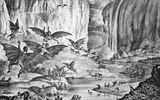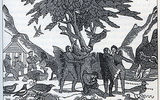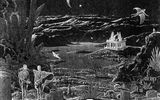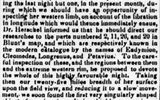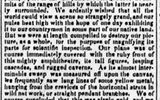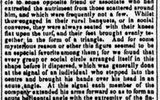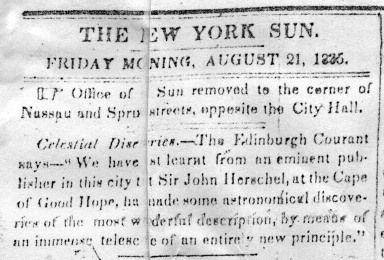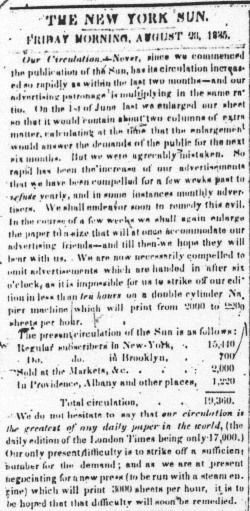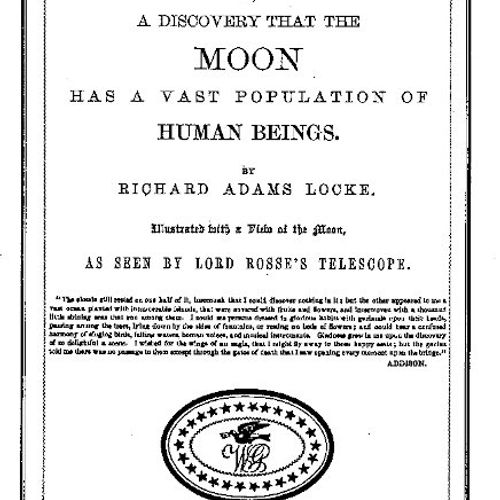
| Added | Fri, 10/12/2021 |
| Источники | |
| Феномены | |
| Версии |
The "Great Lunar Hoax" is a series of six articles published in the New York newspaper "The Sun" since August 25, 1835, about the alleged discovery of life and even civilization on the moon.
First, on August 21, 1835, an advertisement appeared for an upcoming article, allegedly reprinted from the Edinburgh Courant:
"We have just learned from an eminent publisher in this city [Edinburgh] that Sir John Herschel at the Cape of Good Hope, thanks to a huge telescope of a completely new principle, has made several astronomical discoveries of the most amazing content."
The first of the six notes was published four days later, on August 25, 1835 (seeThe full version of the texts of all six publications).
At the very beginning of the article, it was stated that the younger Herschel (Sir John Frederick William Herschel, 1st Baronet), in particular, received a clear image of objects on the Moon, completely similar to how terrestrial objects are visible to the naked eye at a distance of one hundred yards (90 m), and positively resolved the question of whether this satellite is inhabited. In addition, he substantiated a new theory of cometary phenomena and solved or corrected almost all the main problems of mathematical astronomy.
The article also pointed out that the unique telescope consisted of a lens with a diameter of 24 feet (7.2 m), the optical power of which was enhanced by a second lens – a "hydro-oxygen microscope" (Eng. "hydro-oxygen microscope"), displaying an image on a stretched white screen. The small probability of the existence of such a telescope immediately caused some readers to doubt the plausibility of the entire narrative. After all, two years before that (September 11, 1833), an article was published on the pages of the same newspaper about German astronomers who discovered cities and other structures on the Moon, which indicated that with the current state of science and technology, it was impossible to create a telescope that would allow such discoveries. But for most readers, such statements were just another indication of the rapid technological progress of the era in which they lived.
The author of the original text was Dr. Andrew Grant, a former student of Sir William Herschel (the famous father of Sir John Herschel, the discoverer of the planet Uranus). It was claimed that Dr. Grant had written an article about Herschel's discoveries for the Edinburgh Scientific Journal to supplement a more rigorous scientific report that Herschel himself had given to the Royal Society.
As it turned out later, Herschel did not write any reports, did not observe life on the Moon and did not make other astronomical discoveries mentioned in the article. He himself was surprised to learn about this story from publications.
The second article described the moment when Herschel first pointed his telescope at the moon on January 10, 1835. What appeared before his eyes was "a perfectly distinct and even vivid image of basalt rock... the joints of the structures were similar to the joints of the basalt formation in the Staff." Slightly shifting the view, Herschel noticed that the rock was "abundantly covered with dark red flowers." It was also reported that the scientist saw herds of brown quadrupeds similar to bison, a goat "bluish-lead color" and "a strange amphibious creature of spherical shape that rolled along a pebble beach."
The third publication supplemented the description of the lunar flora and fauna. The highlight of this article was the "discovery" of the first representatives of intelligent, albeit primitive, lunar life – bipedal beavers. These extraordinary creatures walked on two legs and carried their cubs in their arms. They lived in huts "taller and better built than those of many savage human tribes." And the signs of smoke over the beaver huts indicated that these highly developed animals had even learned how to handle fire.
On the fourth day, an article was published in which it was written that the scientist had discovered humanoid creatures living inside the ring of red hills, which was called the "Ruby Colosseum". Unlike terrestrial humans, these creatures were "covered, except for the face, with short shiny copper-colored hair and had thin webbed wings without hair that lay tightly on their backs," and the faces of these creatures "had a yellowish flesh color that slightly distinguished them from the faces of large orangutans." The creatures mated with each other in the open air. According to the author of the article, Herschel called them "Vespertilio-homo, or man-bat".
An article published on the fifth day described an even more amazing discovery: an abandoned temple built of polished sapphire was discovered on the surface of the Moon, the roof of which was made of yellow metal and had the appearance of flames rising up and licking a large sphere of smoky copper, "as if hieroglyphically absorbing it."
According to the latest published article, astronomers have discovered representatives of the highest form of Vespertilio-homo living in close proximity to the mysterious sapphire temple. These creatures were "taller than those previously discovered, less dark in color, and in all respects represented an improved variety of the race." Observing these creatures, who spent their time picking fruit, flying, bathing and talking, astronomers realized that their society reigns "a universal state of friendliness among all classes of lunar beings."
Unfortunately, the next day the scientists faced a small problem: they accidentally left the telescope lens in the place where the sun's rays fell on it, as a result of which the wall of the observatory burned down. A week later, after the repair was completed, the moon was no longer visible.
The newspaper expected that sensational articles would cause an increase in sales. Its representatives even claimed that all records were broken in the days of the publication of the articles. However, the texts of the articles were reprinted by almost every newspaper in New York, so there was no significant increase in The Sun's profits. Then the newspaper published the full text of the articles in the form of a separate brochure, and also began selling lithographic engravings depicting bizarre scenes of "Herschel's lunar discoveries".
Thanks to the created hype, the information became wildly popular, and people discussed it everywhere. The story has been widely disseminated, has been translated into different languages and has even become the subject of jokes and discussions in astronomical societies. Many supporters of the "Herschel discoveries" were found even at Yale College, both among students and among professors and teachers.
Interestingly, a little earlier, in June 1835, Edgar Allan Poe published in the first issue of the new Southern Literary Messenger magazine a story about a man from Rotterdam named Hans Pfalz who built a balloon that took him to the moon. Po assured readers that his story told about a real event that happened, but it could not cause a stir among readers.
Seventeen years after the publication of articles in the newspaper "The Sun" William Griggs published a detailed analysis of the lunar hoax. He recalled that he was in New York when the first articles were published, and stood outside the offices of The Sun when crowds of people gathered there to buy brochures with stories about "lunar discoveries".
Griggs wrote that there were skeptics who did not believe in the veracity of the information given in the articles. Most of all, the main competitor of The Sun, The New York Herald newspaper, stood out in this regard, the authors of the articles in which insisted that "the almost universal delight of many people testified primarily to their boundless trust."
According to Griggs, the public not only readily believed in the hoax, but also inspired people who had already independently expressed theses confirming and expanding the published articles. He called this phenomenon "cases of spontaneous lies." For example, one gentleman told a crowd gathered outside The Sun's office that he personally witnessed the loading of the Herschel telescope in London on a ship bound for South Africa. Other people, according to Griggs, claimed that they had copies of the appendix to the Edinburgh Scientific Journal, and assured doubters that the authors of "The Sun" very closely reproduced the text of the original articles describing the "lunar discoveries".
But were there really so many believers, and only a few doubters?
On September 1, 1835, the day after the publication of the last article, "The Sun" presented to its readers eleven comments on "lunar discoveries" taken from articles by authors of other publications, which it considered "competent opinions on the great scientific issues now facing society." They were often cited as proof of the credulity of the people of that time, and only by the end of the 20th century, in 1986, the historian Michael Crowe doubted their authenticity. He studied archival newspaper primary sources and found out that many quotes were incorrectly taken out of context. For example, The Sun quoted the NY Commercial Advertiser: "We think we can see traces of transatlantic origin here." The quote omitted the previous line, which contains an obvious critical message: "We don't understand how a sane person can read this and not recognize the deception."
Thus, there was also a lot of distrust of the information published by The Sun. But why could anyone believe in her at all? Website hoaxes.org indicates several possible reasons:
- In 1835, there was still a debate among scientists about the possibility of life on the moon;
- few readers were well enough versed in optics to understand that the described telescope is impossible;
- the arguments of natural theology, whose supporters have been proving the existence of extraterrestrial (including lunar) life for decades, have become widespread;
- the text of the articles was based on the authority of European science, which Americans treated with great respect (a link to a famous scientist also played a role);
- the articles easily passed the simplest fact check: people knew that there really was an Edinburgh Scientific journal, and that Herschel was definitely in South Africa, where he studied the stars of the Southern hemisphere, and his departure from London to South Africa was widely publicized in 1833;
- The peculiarity of the style of the articles, which often caused the admiration of readers, was the combination of accurate (often obscure) astronomical references with simpler elements, which gave them the appearance of authentic scientific reports of that time.;
- correspondents did not want to officially recognize the articles as fake until they received English or Scottish newspapers confirming this.
On August 28, 1835, The Journal of Commerce for the first time publicly published the assumption that the "lunar discoveries" were a hoax.
Then James Gordon Bennett, in an article published in the August 31, 1835 issue of the New York Herald entitled "Explanation of an astronomical Hoax," presented his arguments in favor of the fact that the story of the "lunar discoveries" was a hoax. He pointed out that the Edinburgh Scientific Journal had stopped such publications as early as 1833. As a confirmation of his point of view, he also quoted an excerpt from a conversation with Richard Adams Locke (the new editor of The Sun), in which he "said that he was engaged in some scientific research" – in particular, optics and astronomy.
Benjamin Day and Richard Adams Locke refused to admit that The Sun's articles were a hoax, but by the end of September letters from Europe confirmed that the "lunar discoveries" were pure fiction.
Later, according to a story first told by Frank O'Brien in the 1928 book The story of the Sun, Locke confessed to a fellow reporter that he was the author of this hoax. His goals were not only to increase the sales of the newspaper, but also to ridicule some of the most extravagant astronomical theories that had recently been published (in particular, about the existence of life on the moon).
However, many supporters of the hoax version believed that Locke simply did not have the astronomical knowledge or creative skills necessary to come up with such a thing.
In 1872, mathematician August De Morgan published an article in which he suggested that the author of the "lunar discoveries" was the French scientist Jean-Nicolas Nicolet. At the time of the publication of the articles by The Sun, Nicolet was living in America, having left France, apparently fleeing from creditors.
In his article , De Morgan wrote:
"There is no doubt that they [the articles on "lunar discoveries"] were written in the United States by Mr. Nicolet, an astronomer who once lived in Paris and escaped from there... These articles were written and sent to France, mainly with the intention of convincing M. Arago, a personal enemy of Nicolet, of their truthfulness. Those who tell this version of the story usually end it by saying that Mr. Arago believed in the "lunar discoveries" and spread stories about them around Paris until Nicolet confessed to the hoax in a letter to Mr. Bouvard."
De Morgan did not provide any evidence to support Nicolet's theory of authorship. And in the subsequent, no evidence was found that Locke and Nicolet had ever met or communicated.
There were several other assumptions about the co-authors of these articles (among which, for example, Lewis Gaylord Clark, the editor of Knickerbocker, was named), but convincing evidence that someone other than Locke participated in their writing was never found.
Interestingly, the public reacted favorably to the information about the drawing, considering it a clever joke, not an evil deception, and as a result it turned out to be an excellent advertisement for the newspaper. In the nineteenth century, this story was popular enough to inspire people to create various products on this topic.
To this day, the "lunar discoveries" remain one of the most high-profile hoaxes in the history of mass media.
Log in or register to post comments
